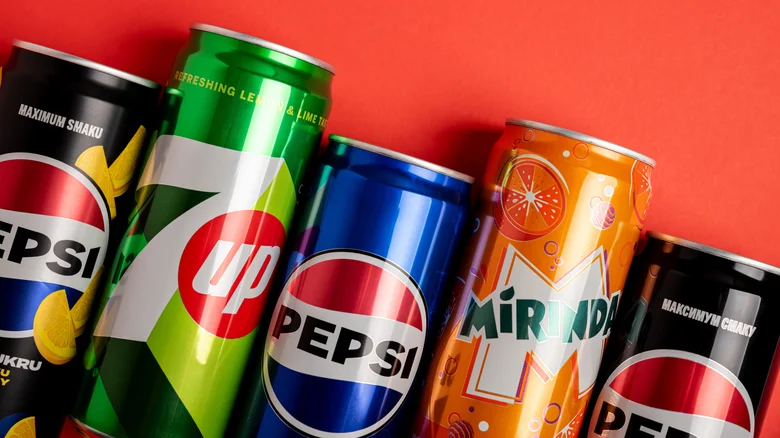Tetiana Shumbasova/Shutterstock
Soda isn’t the healthiest beverage, but it does offer a great energy boost. Most sodas have a good amount of caffeine, but the variety with the most caffeine may surprise you. A 12-ounce can of Mountain Dew Zero Sugar contains around 68 milligrams of caffeine. In comparison, a 12-ounce cup of coffee can have over 200 milligrams of caffeine in it. If you’re looking at a shot of espresso, it has roughly the same amount of caffeine as the aforementioned Mountain Dew………Continue reading….
By Jenna Rapsis
Source: Chowhand
.
Critics:
Caffeine is used for both prevention and treatment of bronchopulmonary dysplasia in premature infants. It may improve weight gain during therapy and reduce the incidence of cerebral palsy as well as reduce language and cognitive delay. On the other hand, subtle long-term side effects are possible. Caffeine is used as a primary treatment for apnea of prematurity,[but not prevention. It is also used for orthostatic hypotension treatment.
Some people use caffeine-containing beverages such as coffee or tea to try to treat their asthma. Evidence to support this practice is poor. It appears that caffeine in low doses improves airway function in people with asthma, increasing forced expiratory volume (FEV1) by 5% to 18% for up to four hours. The addition of caffeine (100–130 mg) to commonly prescribed pain relievers such as paracetamol or ibuprofen modestly improves the proportion of people who achieve pain relief.
Caffeine is a central nervous system stimulant that may reduce fatigue and drowsiness. At normal doses, caffeine has variable effects on learning and memory, but it generally improves reaction time, wakefulness, concentration, and motor coordination. The amount of caffeine needed to produce these effects varies from person to person, depending on body size and degree of tolerance. The desired effects arise approximately one hour after consumption, and the desired effects of a moderate dose usually subside after about three or four hours
Caffeine can delay or prevent sleep and improves task performance during sleep deprivation. Shift workers who use caffeine make fewer mistakes that could result from drowsiness. Caffeine in a dose dependent manner increases alertness in both fatigued and normal individuals. A systematic review and meta-analysis from 2014 found that concurrent caffeine and L-theanine use has synergistic psychoactive effects that promote alertness, attention, and task switching; these effects are most pronounced during the first hour post-dose.
Caffeine is a proven ergogenic aid in humans. Caffeine improves athletic performance in aerobic (especially endurance sports) and anaerobic conditions. Moderate doses of caffeine (around 5 mg/kg) can improve sprint performance, cycling and running time trial performance, endurance (i.e., it delays the onset of muscle fatigue and central fatigue), and cycling power output. Caffeine increases basal metabolic rate in adults. Caffeine ingestion prior to aerobic exercise increases fat oxidation, particularly in persons with low physical fitness.
Caffeine improves muscular strength and power, and may enhance muscular endurance. Caffeine also enhances performance on anaerobic tests. Caffeine consumption before constant load exercise is associated with reduced perceived exertion. While this effect is not present during exercise-to-exhaustion exercise, performance is significantly enhanced. This is congruent with caffeine reducing perceived exertion, because exercise-to-exhaustion should end at the same point of fatigue.
Caffeine also improves power output and reduces time to completion in aerobic time trials, an effect positively (but not exclusively) associated with longer duration exercise. Minor undesired symptoms from caffeine ingestion not sufficiently severe to warrant a psychiatric diagnosis are common and include mild anxiety, jitteriness, insomnia, increased sleep latency, and reduced coordination. Caffeine can have negative effects on anxiety disorders.
According to a 2011 literature review, caffeine use may induce anxiety and panic disorders in people with Parkinson’s disease. At high doses, typically greater than 300 mg, caffeine can both cause and worsen anxiety. For some people, discontinuing caffeine use can significantly reduce anxiety. In moderate doses, caffeine has been associated with reduced symptoms of depression and lower suicide risk. Two reviews indicate that increased consumption of coffee and caffeine may reduce the risk of depression.
One meta analysis has found that caffeine consumption is associated with a reduced risk of type 2 diabetes. Regular caffeine consumption may reduce the risk of developing Parkinson’s disease and may slow the progression of Parkinson’s disease. Caffeine increases intraocular pressure in those with glaucoma but does not appear to affect normal individuals. The DSM-5 also includes other caffeine-induced disorders consisting of caffeine-induced anxiety disorder, caffeine-induced sleep disorder and unspecified caffeine-related disorders.
The first two disorders are classified under “Anxiety Disorder” and “Sleep-Wake Disorder” because they share similar characteristics. Other disorders that present with significant distress and impairment of daily functioning that warrant clinical attention but do not meet the criteria to be diagnosed under any specific disorders are listed under “Unspecified Caffeine-Related Disorders”.
High caffeine consumption in energy drinks (at least one liter or 320 mg of caffeine) was associated with short-term cardiovascular side effects including hypertension, prolonged QT interval, and heart palpitations. These cardiovascular side effects were not seen with smaller amounts of caffeine consumption in energy drinks (less than 200 mg). As of 2007 there is no known antidote or reversal agent for caffeine intoxication.
Treatment of mild caffeine intoxication is directed toward symptom relief; severe intoxication may require peritoneal dialysis, hemodialysis, or hemofiltration. Intralipid infusion therapy is indicated in cases of imminent risk of cardiac arrest in order to scavenge the free serum caffeine. Death from caffeine ingestion appears to be rare, and most commonly caused by an intentional overdose of medications.
In 2016, 3702 caffeine-related exposures were reported to Poison Control Centers in the United States, of which 846 required treatment at a medical facility, and 16 had a major outcome; and several caffeine-related deaths are reported in case studies. The LD50 of caffeine in rats is 192 milligrams per kilogram of body mass. The fatal dose in humans is estimated to be 150–200 milligrams per kilogram, which is 10.5–14 grams for a typical 70 kg (150 lb) adult, equivalent to about 75–100 cups of coffee.
There are cases where doses as low as 57 milligrams per kilogram have been fatal. A number of fatalities have been caused by overdoses of readily available powdered caffeine supplements, for which the estimated lethal amount is less than a tablespoon. The lethal dose is lower in individuals whose ability to metabolize caffeine is impaired due to genetics or chronic liver disease. A death was reported in 2013 of a man with liver cirrhosis who overdosed on caffeinated mints.
Pharmacology of Caffeine. Caffeine”. “
Psychostimulants and cognition: a continuum of behavioral and cognitive activation”.
Encyclopedia of Food and Health.
The 100 Most Important Chemical Compounds: A Reference Guide.
Caffeine in floral nectar enhances a pollinator’s memory of reward”.
Global coffee consumption, 2020/21″.
What’s your poison: caffeine”.
Caffeine and Substance Use Disorders”.
Effects of restricted caffeine intake by mother on fetal, neonatal and pregnancy outcomes”.
Substance-Related and Addictive Disorders”
Tolerance to the humoral and hemodynamic effects of caffeine in man”.
Scientific Opinion on the safety of caffeine”.
Caffeine therapy for apnea of prematurity”.
Long-term effects of caffeine therapy for apnea of prematurity”.
Survival without disability to age 5 years after neonatal caffeine therapy for apnea of prematurity”.
Losing sleep over the caffeination of prematurity”.
Apnea of prematurity: pathogenesis and management strategies”.
Prophylactic methylxanthine for prevention of apnoea in preterm infants”.
Caffeine as an analgesic adjuvant for acute pain in adults”.
Caffeine: Psychological Effects, Use and Abuse”
Caffeine for the prevention of injuries and errors in shift workers”.
.
.







Leave a Reply